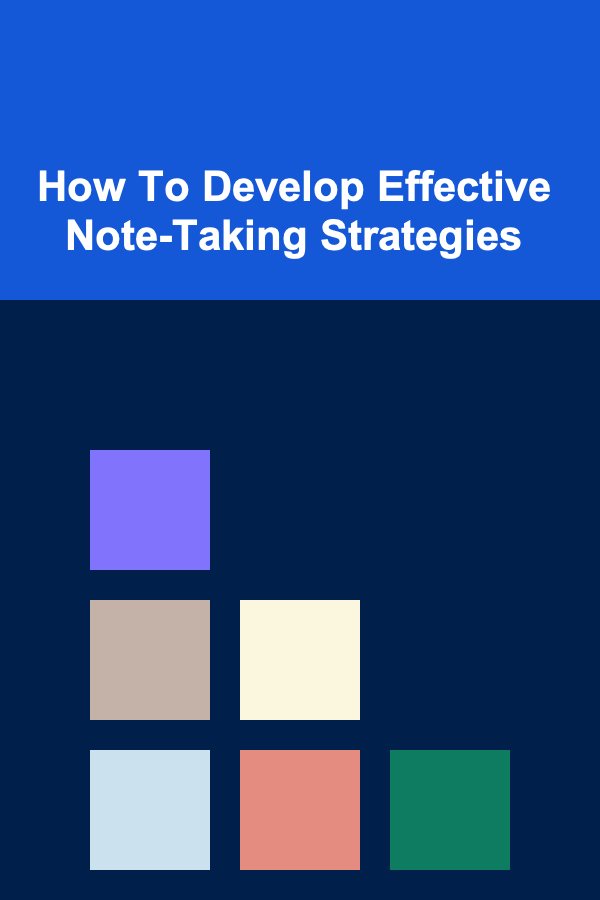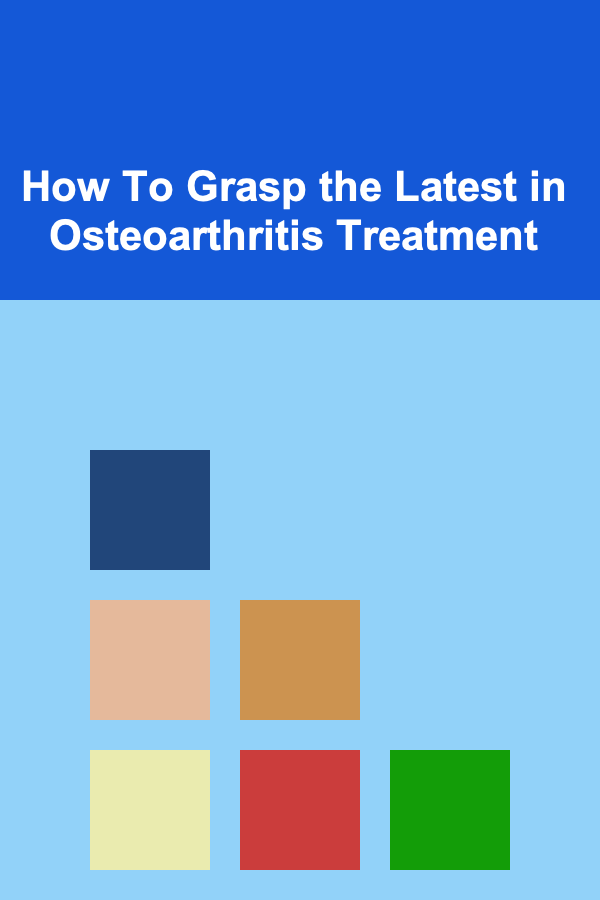
How To Develop Effective Note-Taking Strategies
ebook include PDF & Audio bundle (Micro Guide)
$12.99$8.99
Limited Time Offer! Order within the next:

Effective note-taking is an essential skill for academic success, professional productivity, and personal growth. Whether you're attending lectures, meetings, reading books, or participating in discussions, the ability to take organized and meaningful notes can significantly enhance your learning and understanding of the material. But note-taking is not simply about writing down every word; it's about capturing key information in a way that is efficient, understandable, and useful.
This article will delve deep into the art and science of note-taking, providing practical strategies and insights on how to develop an effective note-taking system that fits your needs, learning style, and goals. From understanding the various types of notes to implementing specific techniques that boost retention, this guide will help you master the skills needed to take your note-taking to the next level.
Understanding the Importance of Note-Taking
Note-taking is more than just a passive act of recording information. It is an active process that helps to engage with the material on a deeper level. Here's why note-taking is important:
- Enhances Retention: Research shows that writing notes by hand improves memory retention better than typing. The physical act of writing forces you to process the information actively, which strengthens neural connections.
- Clarifies Understanding: When you take notes, you're forced to understand the material. By summarizing and rephrasing the information, you clarify the concepts and create mental models that enhance your comprehension.
- Promotes Organization: Effective note-taking systems help you organize the material in a logical and accessible way. Good organization can save time when reviewing and makes it easier to recall important details.
- Provides a Reference: Well-organized notes are an excellent resource for future reference, allowing you to revisit key points quickly. Whether you're preparing for exams, meetings, or brainstorming sessions, your notes are a valuable asset.
- Encourages Active Participation: Note-taking encourages active listening, which helps you engage more deeply with the material. Active participation in the learning process often leads to a better understanding of the topic.
Given these benefits, it's important to develop a note-taking strategy that works best for you. This means considering your goals, the type of information you're recording, and the tools available to you.
Types of Note-Taking Systems
Before you begin developing your note-taking strategies, it's crucial to understand the different types of note-taking systems that exist. Each method has its strengths and weaknesses, and depending on the situation, one might be more appropriate than another.
1. The Cornell Method
The Cornell Method is one of the most widely used note-taking systems, developed at Cornell University in the 1950s. It is effective because it forces you to engage with the material and encourages regular review.
Structure:
- Cue Column: A narrow column on the left side of the page, used for writing key terms, questions, or concepts.
- Note-Taking Area: The large area on the right side where you write down detailed notes during lectures or readings.
- Summary Area: A section at the bottom of the page where you summarize the main points after the lecture or reading.
Advantages:
- Easy to use and review.
- Helps you separate main ideas from supporting details.
- Encourages post-class review with the summary section.
When to Use:
- Lectures, meetings, or readings where the material is presented in a clear and structured manner.
2. The Outline Method
The Outline Method is one of the most straightforward and efficient note-taking techniques. It uses a hierarchical structure where main points are listed first, followed by subpoints and supporting details.
Structure:
- Main ideas are written as headings.
- Supporting points are listed under the relevant heading, indented to indicate their relationship.
Advantages:
- Logical structure that is easy to follow.
- Helps organize ideas hierarchically.
- Quick to review and update.
When to Use:
- Lectures or presentations with clear, structured content that can be broken down into main ideas and supporting details.
3. The Mapping Method
The Mapping Method is ideal for visual learners who prefer to organize information in a more spatial format. This method is based on creating diagrams or mind maps to illustrate connections between different concepts.
Structure:
- Start with a central idea and branch out to related topics and subtopics.
- Use lines, arrows, and branches to show relationships between ideas.
Advantages:
- Great for understanding relationships between concepts.
- Helps visualize complex material in a way that is easy to remember.
- Flexible and creative.
When to Use:
- Complex topics with interrelated concepts.
- Brainstorming sessions or project planning.
4. The Charting Method
The Charting Method is a specialized note-taking technique that involves organizing information into a table or chart format. This is especially useful for comparing and contrasting different concepts or categories of information.
Structure:
- Create columns and rows to categorize and organize information.
- Use headings to label each column and record key details under each heading.
Advantages:
- Useful for comparing and contrasting multiple ideas.
- Helps organize large amounts of data in an easy-to-read format.
- Facilitates quick scanning and retrieval of information.
When to Use:
- When studying material that requires comparison, such as historical events, theories, or data-driven subjects.
5. The Sentence Method
The Sentence Method involves writing down every important piece of information in full sentences, typically in a linear fashion.
Structure:
- Write each new point on a new line, using sentences to capture information as it is delivered.
Advantages:
- Allows for quick recording of detailed information.
- Ideal for fast-paced environments, like lectures where information is presented rapidly.
When to Use:
- Lectures or meetings with a large amount of detailed information, especially if the content flows continuously without clear headings.
Key Strategies for Effective Note-Taking
While the method you choose plays a significant role in how effective your notes will be, the strategies you apply will ultimately determine how well you engage with the material. Here are some key strategies to help you take better, more effective notes.
1. Be Selective: Focus on Key Points
Effective note-taking is not about writing down everything verbatim. It's about identifying the most important concepts, ideas, and facts. Being selective about what you write down forces you to engage critically with the material and helps prevent your notes from becoming overwhelming.
- Listen for cues: Pay attention to verbal cues such as "This is important" or "Remember this."
- Use abbreviations: Develop your own system of abbreviations and symbols to streamline the note-taking process.
- Summarize: Rather than copying entire sentences, try to paraphrase and condense the information into short, concise points.
2. Organize Your Notes Consistently
Regardless of the method you use, consistency in organization is key to making your notes more effective. Whether you use bullet points, numbered lists, or headings, make sure your notes are organized in a way that is easy to follow and review later.
- Use headings and subheadings: Structure your notes with clear headings and subheadings to break down different topics.
- Group related information: Cluster similar concepts or ideas together to avoid confusion and make retrieval easier.
- Use visual elements: Use diagrams, arrows, or underlining to highlight key concepts and show relationships between ideas.
3. Review and Revise Your Notes Regularly
Simply taking notes isn't enough; you need to review and revise them regularly to reinforce what you've learned. Reviewing notes shortly after the lecture or meeting helps to solidify the material in your memory and improves long-term retention.
- Review within 24 hours: Research suggests that reviewing your notes within 24 hours of taking them helps improve retention and understanding.
- Summarize: Write a brief summary at the end of each note session to reinforce the key points.
- Edit: After the initial review, edit your notes for clarity and completeness.
4. Customize Your Approach
Different situations require different note-taking strategies. Be flexible and adapt your method based on the context. For example, during a lecture, you might use the Cornell Method, but for brainstorming or project planning, a mind map might work better.
- Adjust for speed: If the lecture is fast-paced, prioritize capturing key ideas. If it's more detailed, focus on writing full sentences.
- Adjust for content: For complex, interconnected material, use mapping or charting methods to visualize relationships. For linear, straightforward material, use outlining or the Cornell Method.
5. Experiment with Digital Tools
In today's digital age, note-taking doesn't have to be limited to pen and paper. There are a variety of digital tools available that can enhance your note-taking experience. Apps like Evernote , OneNote , and Notion provide features like cloud syncing, organization, and multimedia integration that make it easier to access and organize your notes.
- Use voice notes: If you're on the go, recording voice notes can be an effective way to capture information quickly.
- Multimedia integration: Digital tools allow you to embed images, videos, and links to supplementary material directly into your notes.
Conclusion
Developing effective note-taking strategies is an ongoing process that requires practice, adaptability, and continuous improvement. By understanding the various note-taking methods and applying key strategies, you can improve your ability to retain and understand information. Whether you're in a classroom, a business meeting, or reading a book, effective notes will empower you to engage more deeply with the material and use it in a meaningful way.
Remember that no single strategy works for everyone, and it's important to experiment with different methods until you find the one that works best for you. The ultimate goal is to create a note-taking system that enhances your learning, increases your productivity, and helps you achieve your personal and professional goals.

How to Create a Vintage Lighting Look Without Spending a Fortune
Read More
How to Open Up a Small Kitchen with Creative Renovation Ideas
Read More
Monetizing Deep Learning: 5 Ways to Earn Passive Income
Read More
Why Organizing Your Travel Essentials Reduces Stress
Read More
How To Grasp the Latest in Osteoarthritis Treatment
Read More
How to Create a Business Plan for a Freelance Consultant
Read MoreOther Products

How to Create a Vintage Lighting Look Without Spending a Fortune
Read More
How to Open Up a Small Kitchen with Creative Renovation Ideas
Read More
Monetizing Deep Learning: 5 Ways to Earn Passive Income
Read More
Why Organizing Your Travel Essentials Reduces Stress
Read More
How To Grasp the Latest in Osteoarthritis Treatment
Read More